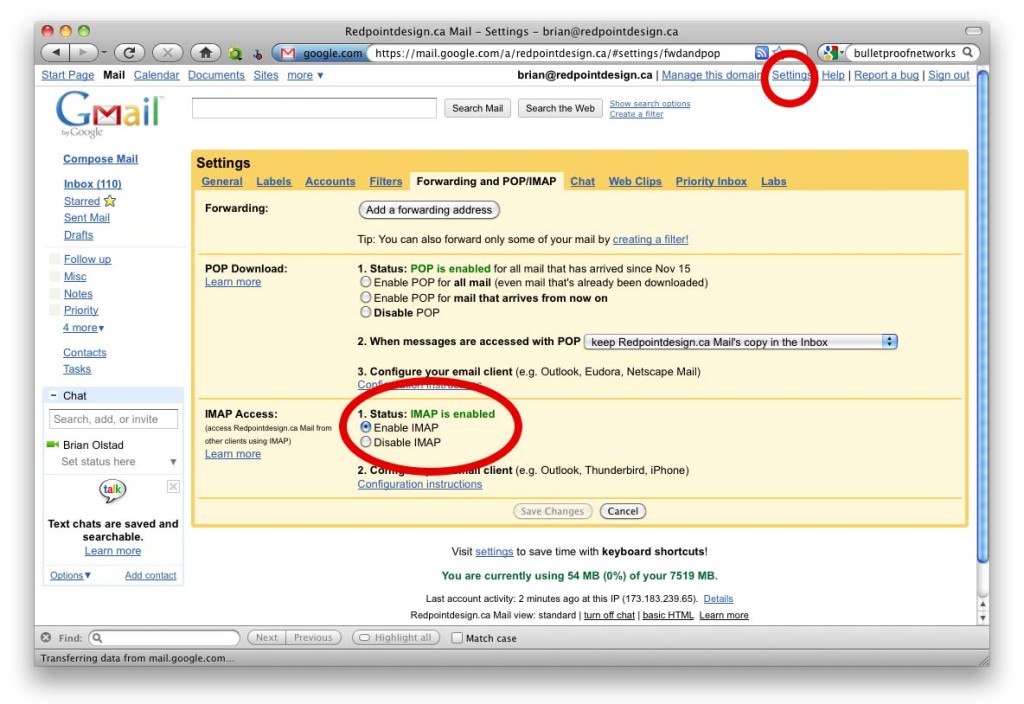Most of our clients receive email one of two ways: on a Microsoft Exchange Server, or through POP/SMTP. For those that use an Exchange server, there is likely an IT staff involved, or at least an external IT supplier like Bulletproof Networks handling the email. For those without IT support, POP is the likely method of email transfer.
Now, Redpoint is not an IT firm – we are a creative agency. We host websites for clients, and help with email config within our scope of expertise. Usually, that includes a couple devices. Recently, I got a new iPhone and as a result, have been managing correspondence more and more on the hand-held. Two things annoy me about email – spam and my laptop and smart-phone missing messages. I also realized I was paying data fees to download 30 spam messages a day on my phone. I know there are clients and people in the general public that suffer the same spam problems.
Enter gMail
We’ve been routing many of our business clients mail through gmail – it is a terrific interface, clients can control their own accounts and the spam filter is terrific! We recently moved the Redpoint mail over to this set-up. The problem is, gmail only allows for one POP mail connection. So in my case, I would receive half my mail on my laptop, and the other half on my phone. Very bad.
With a little research, I set up my laptop with a POP connection and my phone with an IMAP connection. Nothing new here, POP downloads from the server and IMAP just interacts with the server itself. With this, my problems are solved. If your domain is already routing through gmail, it’s a snap to set up. if not, it takes a few extra steps. Here’s the snapshot:
Set your domain up with gmail
If this is not done, you’ll likely need some help. See the sign-up page.
 Turn on IMAP in the gmail webmail settings
Turn on IMAP in the gmail webmail settings
IMAP is off by default, so enable it in the “Forwarding and POP/IMAP” panel.
Create a new account
Create or edit the settings to add an IMAP account. gmail’s help page will help. Setting vary by device, so you’re on your own a bit here.
That’s it!
NOTE! Replacing a POP email account with a IMAP account will empty your inbox on the device (not the server). proceed with caution and backup important information – you may lose it! Choosing to play around with settings you don’t understand may result in data loss.


Awesome Jordan! Thanks! SO many options…
I should also note that this has the added benefit of marking your emails read across the board, which IMAP doesn’t always do. So if you check an email on your iPhone it will also be marked as read on your laptop, desktop, webmail, etc. Also, with gmail setup as an exchange box any thing you send will be placed in the sent folder on all devices as well, so you can look back at correspondence on all devices. IMAP usually will do this but it doesn’t always work properly.
You can actually setup gmail as an exchange account provider on your iPhone. This not only allows you to get around that problem of POP only getting half your emails, but also allows you to sync your contacts and google calendar with the phone as well. The contacts sync is one of the most useful and unknown features because you can sync all of your existing iPhone contacts to contacts.google.com and manage them from there and the changes are instantly reflected on your phone. It also works great to back up your contacts in case you have a bad upgrade on your iPhone and lose everything. To set this up on the iPhone just add a new ‘Microsoft Exchange’ account and for the server use m.google.com. Once it is setup goto m.google.com/sync in Safari on your iphone to choose which calendars you want to sync (if you choose to set that up). This works much better than IMAP. You can read google’s official instructions here: http://www.google.com/support/mobile/bin/answer.py?answer=138740&topic=14252